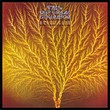|
|

From head to heart Following our retroscope series going on for several years, here we go again. Yes, for one more year! Here's
Speakers' corner's cousin; From head to heart. Luna Kafé's
focused eye on great events, fantastic happenings, absolute milestones, or other curious incidents from the historic shelves'n'vaults of pop'n'rock. Blowing our ears and our head, punching
our chest and shaking our heart, or simply tapping our shoulder. Making us go sentimental, but not slaphappy. This moonth we put the LK spotlight on a 40-year-old platter, a child of the progressive
and experimental 1970s.
1975 and 1976 was a really creative and productive period for the reformed Van der Graaf Generator. Not only did they record three albums in less than a year and toured intensely, including their first concerts in North America and had to cancel several shows in Italy due to riots and theft of their gear. The band's main lyricist and tunesmith Peter Hammill recorded two of his best, and quite different, solo albums in about the same period, helped out by current and future members of the band. The classic line-up was intact until the end of 1976 and in addition to Hammill (vocals, piano and guitar) included Hugh Banton (organ, including bass pedals, bass guitar and a little bit Mellotron), Guy Evans (drums and percussion) and Dave Jackson (saxophones and flute). Three of Still Life's five songs were recorded at Rockfield Studios near Monmouth in the Welsh countryside in January 1976. The two others had been recorded the same place the previous June during the Godbluff sessions. They didn't fit thematically with the Godbluff songs and were too long anyway to fit along with the others in the LP format. But it didn't mean they were any weaker than the songs of the previous album. Still Life opens with "Pilgrims" from the Godbluff sessions. A bit low-key and depressed at first, but it turns out to be an uplifting song about ...HOPE! Quite different from the usual gloom & doom. Splendid organ playing throughout, great drums and sax fills in between. A really one of a kind song from the VdGG gang. Pilgrims was also the name of a Van der Graaf and Peter Hammill fanzine that kept spirits alive when Hammill struggled as a solo artist out of touch with the popular trends in the latter half of the 1980s and first half of the 1990s before the Internet secured renewed interest in him and the band that had thrown in the towel back in 1978. I remember vividly a solo performance by Hammill in the Dolomites in Italy in 1996 where we had to climb a few hours in the mountains to 3 000 metres above sea level to witness his acoustic performance. On the way down to the valley afterwards in the late afternoon Pilgrims editor Fred Tomsett started to sing from the song that had named his fanzine. Very appropriate: I climb through the evening, alive and believing The other Godbluff-session song here, "La Rossa", is very different. An energetic organ and sax-driven hard rocker most of the time, with some moments to gain breath in between. Allegedly about a red haired Italian woman, a long-time platonic friend. Hammill sings about physical lust in his most roaring shout-singing way, with the anguish and frustrations directed against himself, the dancing organ-monkey. If we make love now it will change all that is yet to be... Probably not the average progressive rock fan's cup of tea, but it surely inspired some aspiring punk vocalist that were about to be born around the release of Still Life. And it points forward towards the revised, punky version of Van der Graaf of 1977 and the album The Quiet Zone/The Pleasure Dome. Though at the very last seconds, "La Rossa" ends in a pompous and bombastic way, in stark contrast to the rest of the song. The remaining three songs were rehearsed for eight days in a posh rural mansion in Gloucestershire before the recordings of the songs started. This means they're probably the most well-rehearsed songs on any Van der Graaf Generator album. In stark contrast to "La Rossa", "My Room (Waiting For Wonderland)" that kicks off side 2 of the LP doesn't have much force in the kick. It's soft and the late night sax playing makes it even softer. I'm no big fan of saxophone in rock, but David Jackson is one of the glorious exceptions. Only not all of his playing on this song. It tries to be so sincere and emotional, but it doesn't seem to be for real. The song itself, however, is great. This is probably the song that has opened most of Peter Hammill's solo concerts through the years. But that's another and much more powerful version, especially towards the end of the song. It's probably one of his most challenging vocal performances, too, that really set his vocal chords in motion and includes some of the lowest and highest notes of his vocal register. It's one of the few VdGG songs hardly without any organ playing at all. Instead Hugh Banton plays bass guitar here and proves he manages the task as effortlessly with his hands as his usual toes. To me the highlight of the Still Life version of the song arrives after about four and a half minutes, after the song has come to a temporary halt. When it carefully starts again there are a few seconds with some heavenly reverbed piano, angelic echoed vocals and discreet organ before the lazy sax re-enters. Sublime! In the title track Hammill philosophises about immortality, dark immortality. He concludes that it is not something to aspire at: Arrival at immunity from all age, all fear and all end.... The first couple of verses are like a normal-length sad pop-ballad, only armed with discreet organ. After a little less than three minutes the rest of the band joins in, the rock and rôle vessel gets started and the next third of the song is an energetic beast with soothing organ, bass, drums, sax-fills and the occasional Hammill howls. It ends almost in the same way as it started, mainly with piano as discreet as the organ in the beginning. This was the song that in public marked what evolved into the start of the last reformation of Van der Graaf Generator. It was performed as the encore of a Hammill solo gig in London in 2003 when all members met on stage for the second time since the Generator folded by the end of 1976. And then there is the grand opus that finishes off the album, the 12 and a half minutes long "Childlike Faith In Childhood's End". I can't claim that I understand so much of what Hammill is singing about here. As far as I reckon, the song deals with existentialism. At least partly inspired by Childhood's End, one of the best known novels by sci-fi writer Arthur C. Clarke (yes, he who also wrote the novel and co-wrote the screenplay of 2001: A Space Odyssey). Childhood's End the novel, tells the story of extra-terrestrials taking peacefully command on Earth. The human race prosper under their rule for some decades, but doesn't seem to have any challenges any more. And then... The lyrics of the song seem to incorporate human problems faced in the novel with some of the others of the Still Life lyrics, most notably the title track and "Pilgrims", and beyond. The song starts with beautiful flute playing by David Jackson and nearly inaudible vocals. Then builds up to the quite hard rock (compared to the then contemporary scene, that is, but not as hard as "La Rossa"), organ-driven standard of the album, quietens again, builds up again etc., evolves into something close to pompous symphonic rock, but manages to steer clear by moving into a minimalistic jazzy instrumental interlude. The song has several facets and time signatures, a true prog-rock offering. Though dominated by Banton's organ and bass pedals, the steady rhythms and sax riffs are also all-important. We may even discern Hammill's electric guitar here now and again. Surely the monumental Work of the album. To sum up: It has been very awarding to revisit this album for the first time in a long while and allow the songs to creep under my skin, again. I tend to prefer Godbluff from this era of the band. Sure, Godbluff is a more cohesive album. But there are no weak songs on Still Life either. There's only the partly weak sax arrangement of "My Room" that I could have wished for being revised. Otherwise impeccable! The first times I encountered Still Life, I found "Childlike Faith..." to be a bit hard to swallow. By listening quite intensively to the album for some days now, it's turned into one of my all-time VdGG favourites with all its different themes, even though I still don't understand all of the lyrics. What about the cover, you may ask. Well it's not an illustration of the root-system of a big tree or plant turned upside down, some sea-weed or a river-system seen from high above. Let's give the word to saxman Jaxon: 'I do remember finding the picture that was the cover of Still Life. I found it in a magazine. It's a picture of some clever process where they got a Van de Graff Generator high voltage spark and put it through some acrylic thing and filmed it. I just happened to find some picture of it and thought, "Good lord, that's what a Van der Graaf does!" I showed it to the rest of the guys and they said, "Alright, that's the cover then."' Lyrics excerpts taken from Peter Hammill's home page Sofa Sound. The Jaxman quote from Van der Graaf Generator, The Book by Phil Smart and Jim Christopulos (published by 'Phil and Jim' 2005). Copyright © 2016 JP
|
| You may also want to check out our Van der Graaf Generator articles/reviews: Merlin Atmos - Live Performances 2013, ALT, After The Flood - At The BBC 1968-1977, Do Not Disturb, Godbluff, Present, Real Time, The Box, The Least We Can Do Is Wave To Each Other + H To He Who Am The Only One + Pawn Hearts. |
| © 2016 Luna Kafé |
 Van der Graaf Generator
Van der Graaf Generator